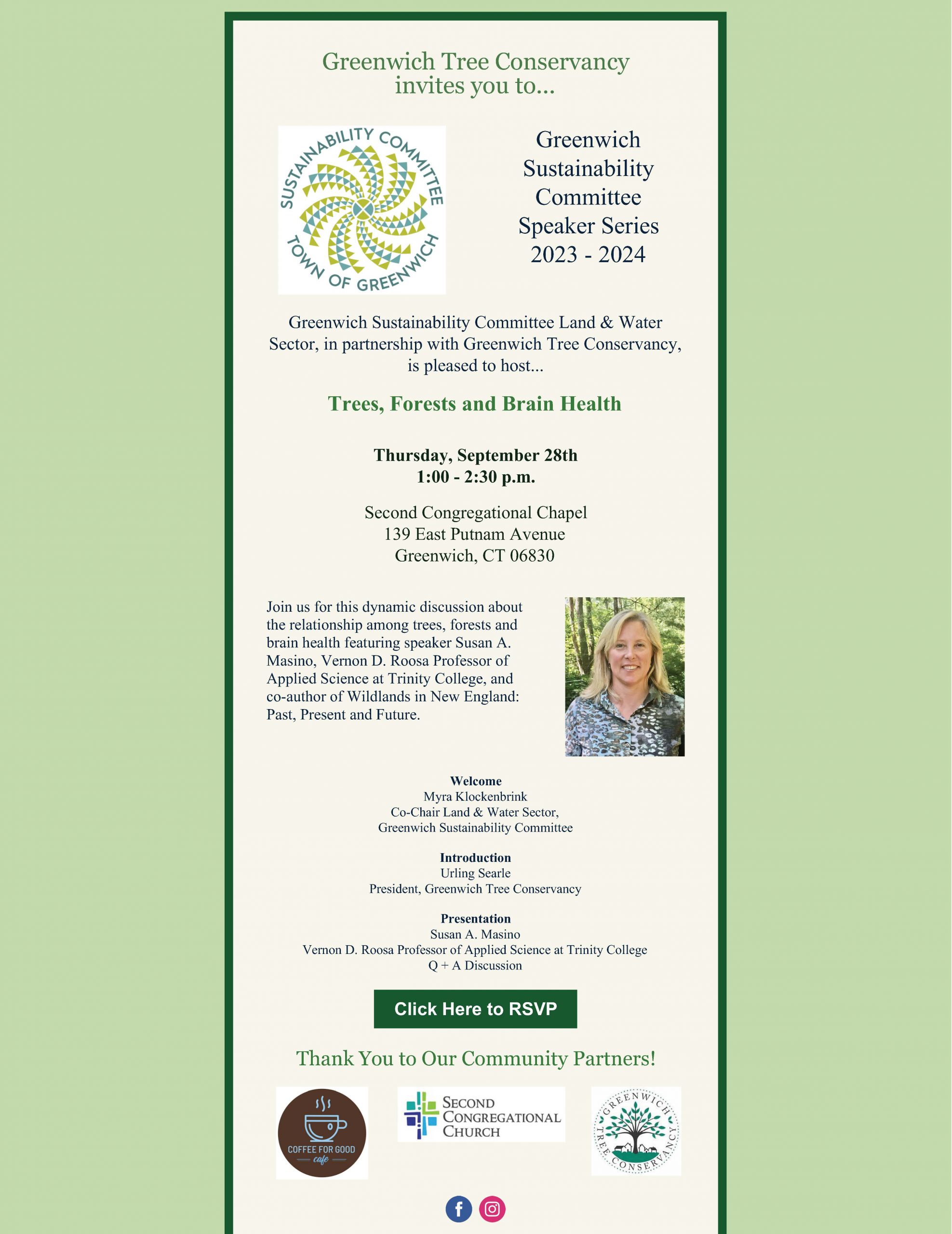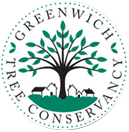Gathering Honors John R. Conte Jr at Tree Dedication Ceremony
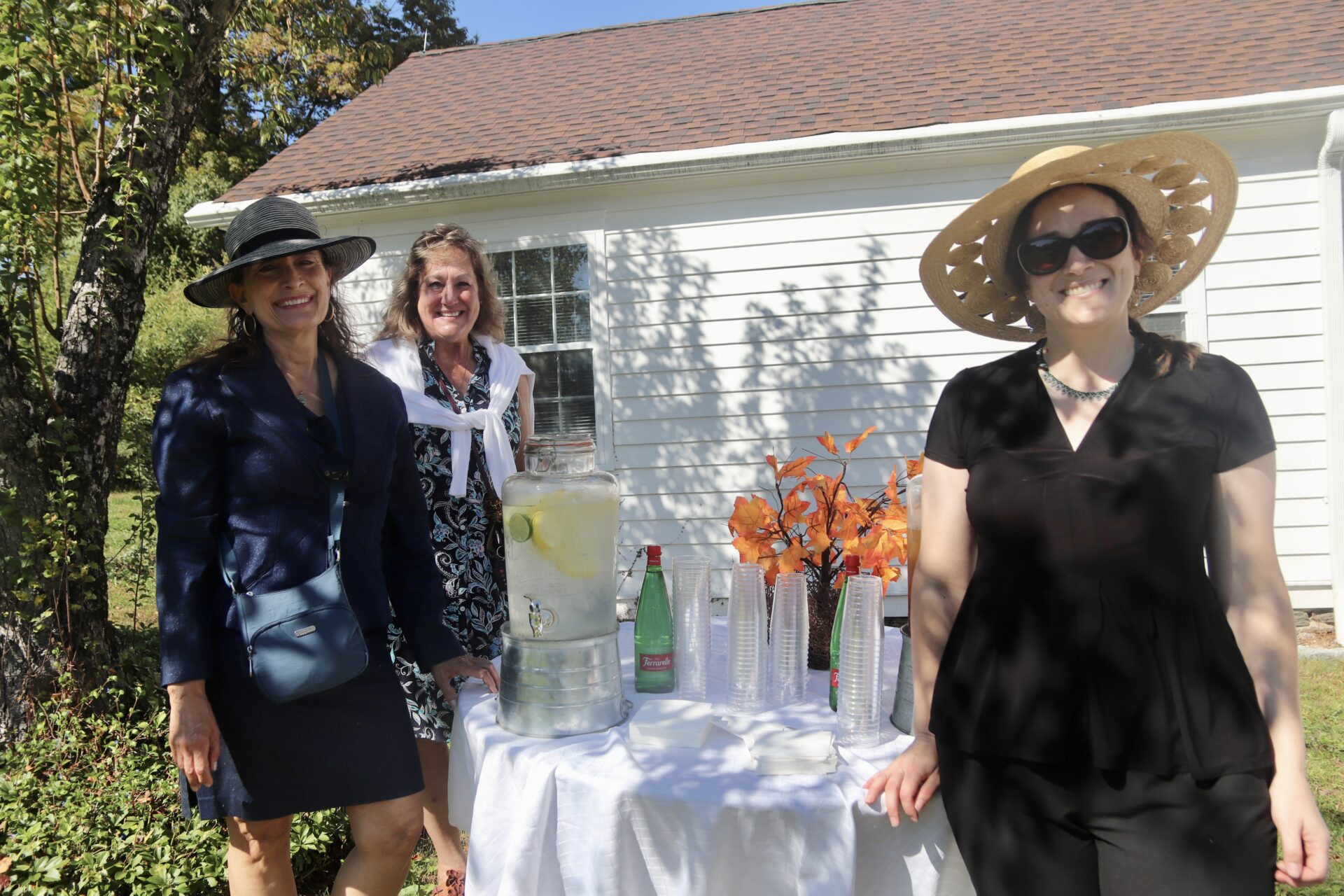
By Greenwich Free Press
A group of about 50 people gathered at First Church of Round Hill in back country for the dedication of a newly planted tree in honor of John R. Conte Jr. Mr. Conte was president of Greenwich Tree Conservancy when he died unexpectedly on April 22, 2025.
Leslie Lee, interim president of the Greenwich Tree Conservancy, said the tree was planted in loving memory of Mr. Conte.
She shared a message from GTC founder Peter Malkin, who said that Conte shared a special combination of landscape expertise and social responsibility.
“His redesign of Greenwich Common and his concern for public spaces throughout the town complimented his many beautiful private property landscapes,” Malkin said.
The newly planted tree was selected by the town tree warden, Dr. Greg Kramer is a Valley Forge Elm.
“This may look like a little guy right now, but it is disease resistant and will grow quickly – up to three feet a year – when fully grown it will measure up to 70 feet high with a canopy spread of 60 feet, a magnificent tribute to John for many years.”
The tree was acquired by Sam Bridge Nursery and planting donated by Conte & Conte.
Ms Lee showed a facsimile of a bronze plaque that will be permanently installed in the base of the newly planted tree in Mr. Conte’s honor.
The tree was planted behind the stump of a mature Elm Tree that had died and was taken down over the summer.
Selectperson Janet Stone McGuigan read a proclamation from the Board of Selectmen describing John R. Cone Jr’s contributions to the Town of Greenwich. Conte was a licensed arborist who grew a family business into Fairfield House and Garden, specializing in landscape construction and fine home building before founding Conte and Conte, offering Landscape Architecture and Engineering Design that helped make Greenwich a greener community.
He served on the Greenwich Inland Wetlands and Watercourse Agency and the town’s Architectural Review Committee.
He also served as President of the Greenwich Tree Conservancy, Greenwich Green & Clean and the Round Hill Association. He was on the board of Family Centers, the Greenwich Chapter of the Boy Scouts, the Greenwich Land Trust and Greenwich Audubon.
John Conte’s sister Cheryl said she and her brother loved the town of Greenwich and the family moved to town in about 1950.
“He knew this was the place we wanted to build his business and have his family,” she recalled.
Cheryl Conte said their father John R. Conte Sr came to the United States from Italy at the age of 11, not speaking a word of English, and only attended school through the 8th grade, in order to work and help the family.
“Our dad was a natural salesman and a natural entrepreneur. He started his business in Greenwich with a landscaping and tree work. His love for trees led him to go to school to get a license as a tree surgeon,” she said. “The apple didn’t fall far from the tree. John Jr would accompany his dad on jobs and he would learn the names and characteristics of all the trees.”
“John grew up appreciating and loving trees and nature and beauty. I can hear and imagine my dad saying, ‘Isn’t that beautiful!’ when we drove around town.”
She described her brother as a creative genius who used his talent and gifts to benefit all those around him: the town, the world and all those privileged to know him.
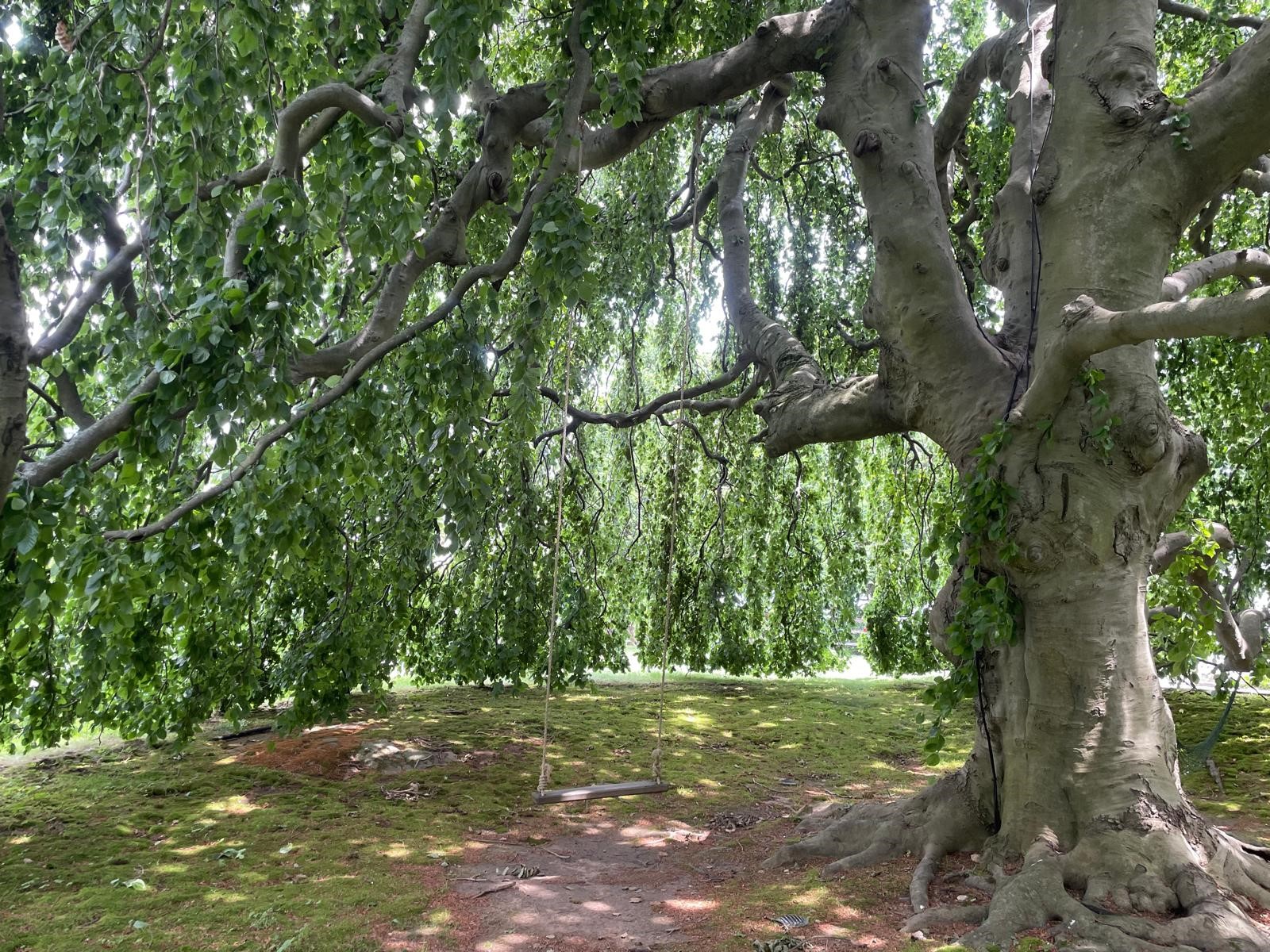
Treasured trees submission photo by Elizabeth Sadock.
By Kate Dzikiewicz
Join us for an evening of cocktails and hors d’oeuvres to honor this year’s Treasured Trees winners.
Additionally, this year we will be recognizing the owners of statewide Champion Notable Trees.
A treasured tree is loved for many reasons:
• Its special history
• A special memory or story
• Its magnificent size
• Its age
• Its pedigree species
• Its unique shape
• Its spring flowers or fall foliage
These special trees include several that are Connecticut record-holders for their size and age.
We are excited to come together in support of our mission to preserve and enhance the tree canopy of Greenwich to benefit the community, its health, and its quality of life.
For more information and to purchase tickets please click here.
Sam Bridge Nursery and Greenhouses is located at 437 North Street in Greenwich.
Kate Dzikiewicz
Executive Director, Greenwich Tree Conservancy
View the article in the Greenwich Free Press here

By Kate Dzikiewicz
There is growing awareness in Connecticut of the damage caused by invasive plants, yet many homeowners, landscapers, and gardeners remain unaware of the serious threat posed by English ivy. Long valued as a low-maintenance and attractive ground cover, English ivy grows quickly, thrives in a wide range of conditions, stays green through winter, and adds a sense of elegance to landscapes. Ironically, these same traits make it especially destructive when left unchecked.
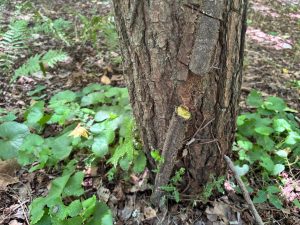
Like other ivies, English ivy is a vigorous climber. Its vine roots secrete a glue-like substance that allows it to cling tightly to bricks, stone, trees, and other surfaces. On buildings, ivy traps moisture, loosens masonry, and accelerates structural decay. However, on trees the harm can be far worse.
Unlike native vines like poison ivy, which typically coexist with trees, English ivy can overwhelm trees in yards or natural spaces. It forms thick woody stems that can reach a foot in diameter. The added weight from English ivy vines dramatically increases the risk of lost branches during snow or storm events. As it climbs, the ivy shades out leaves, causing branches to die and decreasing the tree’s overall health and vitality. Property owners may first notice dieback in lower branches, but over time, the entire canopy can be compromised.
This decline often goes unnoticed because it happens slowly, sometimes over many years. By the time the damage is obvious, the tree may already be beyond saving. This is why it is critical to intervene early. When ivy is just beginning to spread on the ground or at the base of a tree, it can be pulled by hand. Once vines have adhered to bark, however, more care is needed. Pulling vines that are strongly attached will damage the bark of a tree and can increase the risk of infection.
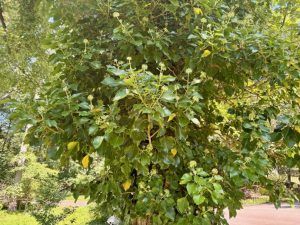
The safest method for removing English ivy from trees, especially larger vines, is to cut the stem close to the ground. Then, make a second cut six to twelve inches higher and remove that section of vine. Growth above this point will die and eventually fall away naturally. Applying herbicide to the rooted stem can provide extra assurance that the ivy will not resprout. Though dying ivy clinging to a tree may be unsightly for a season, it is the best way to ensure the tree’s long-term survival.
Because birds eat English ivy berries and spread the seeds through their droppings, it can appear even where it has never been planted. For this reason, it’s wise to regularly check your yard, garden, or nearby woodland for its telltale vines. In Fairfield County, several local organizations actively cut back ivy in parks and forests to protect our community trees.
Although English ivy is still legal to purchase in Connecticut, we strongly recommend homeowners and businesses choose alternatives. Many beautiful, low-maintenance ground covers exist that provide the same lush look without threatening the health of trees or the integrity of buildings. English ivy may be traditional, but it comes at too high a cost.
Kate Dzikiewicz
Executive Director, Tree Conservancy
Read the story on the Greenwich Sentential here
The Greenwich Tree Conservancy Plants Trees for Cooler Streets and Parking Lots in Greenwich

By Kate Dzikiewicz
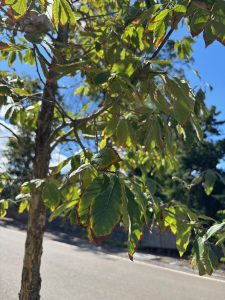
This summer, the Greenwich Tree Conservancy, in partnership with the Town of Greenwich, added new trees to municipal parking lots, Eugene Morlot Memorial Park, and the Byram neighborhood to help reduce the urban heat island effect and improve canopy coverage. Parking lots in particular benefit from trees, which cool pavement, shade parked cars, and enhance appearance. Plantings took place in the Henry Street, Bruce, and East Elm lots, with more sites planned for the autumn planting season.
In Byram, where dense development and limited tree cover increase heat impacts, new trees will bring much-needed shade and improved air quality. Several ailing trees from last year’s Putnam Avenue Beautification Project planting were also replaced.
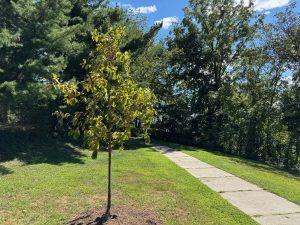
Species were selected by Superintendent of Parks & Trees and Tree Warden Dr. Greg Kramer, with priority given to native shade trees that would remain healthy under harsh near-street conditions.
The Greenwich Tree Conservancy looks forward to focusing on planting trees at schools during the autumn planting season.
Residents interested in additional street trees near their homes or businesses are encouraged to contact the Greenwich Tree Conservancy.
View article on the Greenwich Free Press here.
Tree Power: Nature’s Air Conditioners

By Kate Dzikiewicz
After a cool and rainy spring, the heat of summer has finally arrived in Greenwich. Longtime residents may have noticed summers gradually getting warmer over the past few decades, and heat waves are becoming more frequent and intense. To keep comfortable, we crank up the air conditioners, but trees offer a powerful and natural way to fight the heat.
As the Town of Greenwich continues to develop and expand, the region loses tree cover, especially in urban areas. This contributes to the urban heat island effect, a phenomenon which describes how urban neighborhoods are often significantly warmer than nearby rural areas. Many factors contribute to this effect, especially dense concentrations of impermeable pavement and buildings built from materials like concrete and asphalt. These manmade materials retain and radiate a lot more heat than soil or sand. Limited green space and lack of shade only make matters worse for urban residents.
According to the EPA, urban areas can be 18–27°F warmer than nearby undeveloped spaces. This temperature spike does more than just increase energy use during warm months; it also worsens air pollution and raises the risk of heat related illnesses and deaths. Vulnerable populations, including the elderly and people with health conditions, are especially at risk, but high heat affects everyone, lowering productivity and quality of life.
While any greenery helps cool an area, trees are the most effective. Their leaves and branches block up to 90% of sunlight before it reaches the ground. Rather than being retained as heat, this solar energy is used to convert carbon dioxide and water into sugars via photosynthesis. Buildings shaded by trees can see surface temperature reductions of 20–40°F, and parked cars under tree cover can be up to 45°F cooler. No wonder shaded parking spots are always in high demand!
Trees have another less visible way that they cool the air. They absorb water through their roots and release it from their leaves as water vapor in a process called evapotranspiration. Evaporation draws heat from the environment, making trees living evaporative cooling systems. A single mature oak tree can release up to 40,000 gallons of water into the air each year, and a tree-lined street multiplies these benefits.
Any sort of planted green space will help reduce heat in a neighborhood, but large mature trees have the greatest cooling impact. This is why the Greenwich Tree Conservancy advocates retaining these large mature trees whenever possible. It can take decades for young trees to reach the size and impact of their mature counterparts, and removing a single large tree from your property can make for a big decline in your comfort during the summer.
If you want to help keep your home or business cooler and contribute to a healthier community, consider planting more trees and protecting the ones already in place. Trees placed on the west and southwest sides of buildings are especially effective at reducing afternoon heat. Just be sure to choose species suited to our local climate and urban conditions.
Trees are important in every season, but in summer we have even more reasons to appreciate them!
Kate Dzikiewicz
Executive Director, Greenwich Tree Conservancy
Read the story on the Greenwich Sentinel here
Want to See Your Future Tree? Explore the Town Arboretum
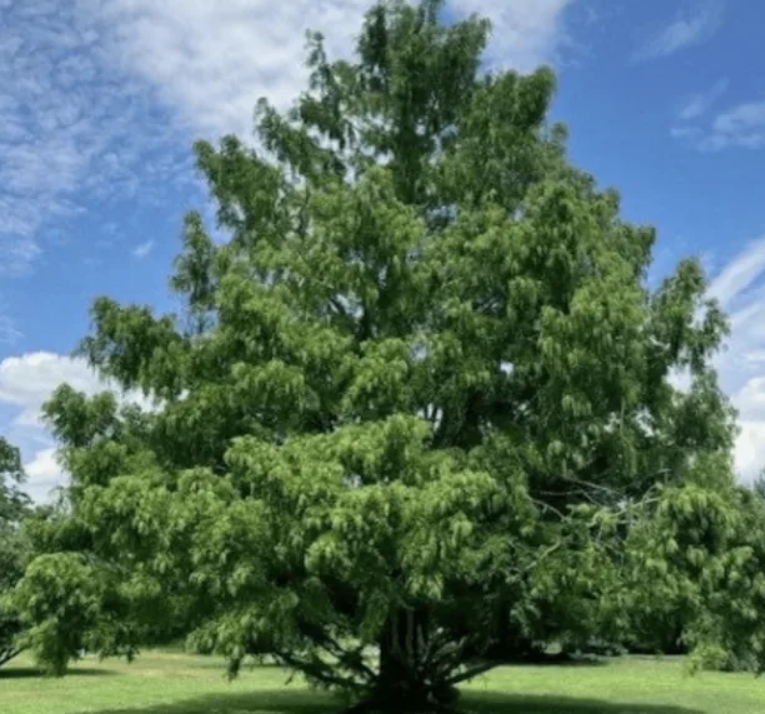
By Cheryl Dunson
The Greenwich Town Arboretum is internationally accredited by ArbNet, the sole body which awards accreditation to arboreta worldwide. The Greenwich Tree Conservancy (GTC), in partnership with the Greenwich Department of Parks and Recreation, submitted a successful application and our arboretum was established in 2016. Criteria for accreditation include: a governance group, 100+ labelled tree species, and educational programming. If you visit the ArbNet website, you will see the Greenwich Town Arboretum listed among arboreta from around the world, including Kew Gardens in London. To see our listing and learn about other arboreta visit: https://arbnet.org/morton-register/accredited-arboreta/all
A 2009 Historic Parks of Greenwich report commissioned by the Greenwich Division of Parks and Trees served as the guide for the establishment of the Greenwich Town Arboretum. The report provided a wealth of background information about our four historic parks which “launched” the Arboretum: Bruce Park, Byram Park, Binney Park and the Montgomery Pinetum.
Bruce Park, approximately 60 acres, is Greenwich’s oldest public park. It was established in 1908 through a bequest of Robert Bruce. In 1930, the Town paid for a survey and development plan for Bruce Park which is located on the south side of I95. Significant trees identified at that time included beech, maple, ash, cherry, dogwood and sycamore. Today, the oaks and sweetgums are particularly striking.
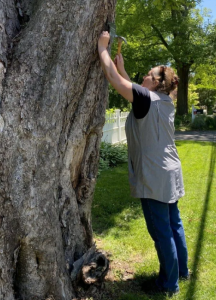
Byram Park, in southwest Greenwich, was established in 1919. It is approximately 30 acres and fronts Long Island Sound. The original acreage was a former granite quarry and the exposed granite cavities remain clearly visible today. In 1975, 10 acres were added to the east end of the park, part of a private estate then known as “The Anchorage.” Many mature deciduous and coniferous trees are part of Byram Park’s original section near the entry gate and near the playground. These mature species include oaks, tulip trees, and sugar maples.
The land for Binney Park in Old Greenwich was purchased by Edwin Binney in 1927 with the intent to deed it to the town exclusively for recreation and park uses. The design and construction of the park took over 4 years. It is interesting to note that James A.G. Davey of Davey Tree Company was Binney’s son-in-law and advised on the design of the park. Among other elements, the plan called for the planting of many trees and the creation of two small “lakes.” In 1933, Binney Park was dedicated. Tree species included pin oak, red maple, paper birch, tupelo, dogwood, hawthorn, and American ash.
The Montgomery Pinetum in Cos Cob is approximately 100 acres and is adjacent to the Pomerance and Tuchman town-owned properties. Colonel Robert Montgomery purchased the property known as “Wild Acres” in 1922. He and his wife developed the property adding gardens, paths and buildings including a high-ceilinged greenhouse for fruit tree propagation. Col. Montgomery established the Pinetum in 1930. He planted abundantly and eventually acquired over 850 coniferous species.
In 1945, he gifted his 200 best specimens to the New York Botanical Garden. After Col. Montgomery’s death in 1952, his wife approached the Town about donating the property with restrictions that it be used for walking trails, horticulture and the arts. The Town voted to accept the gift in 1953. Some conifer specimens planted under Col. Montgomery’s direction remain today along with many species of ornamental shrubs and trees.
Since the launch of the Greenwich Town Arboretum, the GTC has planted and labelled trees in our four historic parks and expanded to other areas like Greenwich Point, Cos Cob Park, school properties, neighborhood centers, and town-owned parking lots. Greenwich is unusual because our arboretum is truly town-wide. To date, we have labelled over 1350 trees! Residents can help us maintain tree labels in good condition. Whether due to storms, aging or occasional vandalism, sometimes labels come loose from a tree. We would appreciate the public’s help in notifying us via email at Arboretum@GreenwichTreeConservancy.com if they see a label that is damaged, dangling, or missing.
The Greenwich Tree Conservancy’s mission includes helping to preserve our Town Arboretum as a living museum of trees and as a treasured community asset for current and future generations. The Arboretum collections include both specimens from native ecosystems and species representing botanical diversity from around the world. The GTC works to promote a deeper knowledge of trees through public events, educational programs, and through research. We are only able to do this work through the generous support of residents.
To find out more about the Greenwich Town Arboretum, our programming and more, visit us at www.greenwichtreeconservancy.org
Cheryl Dunson, Greenwich Tree Conservancy Advisory Board Co-Chair
Read the story here on the Greenwich Sentenial
New Elm Tree at First Church of Round Hill Will Honor John Conte
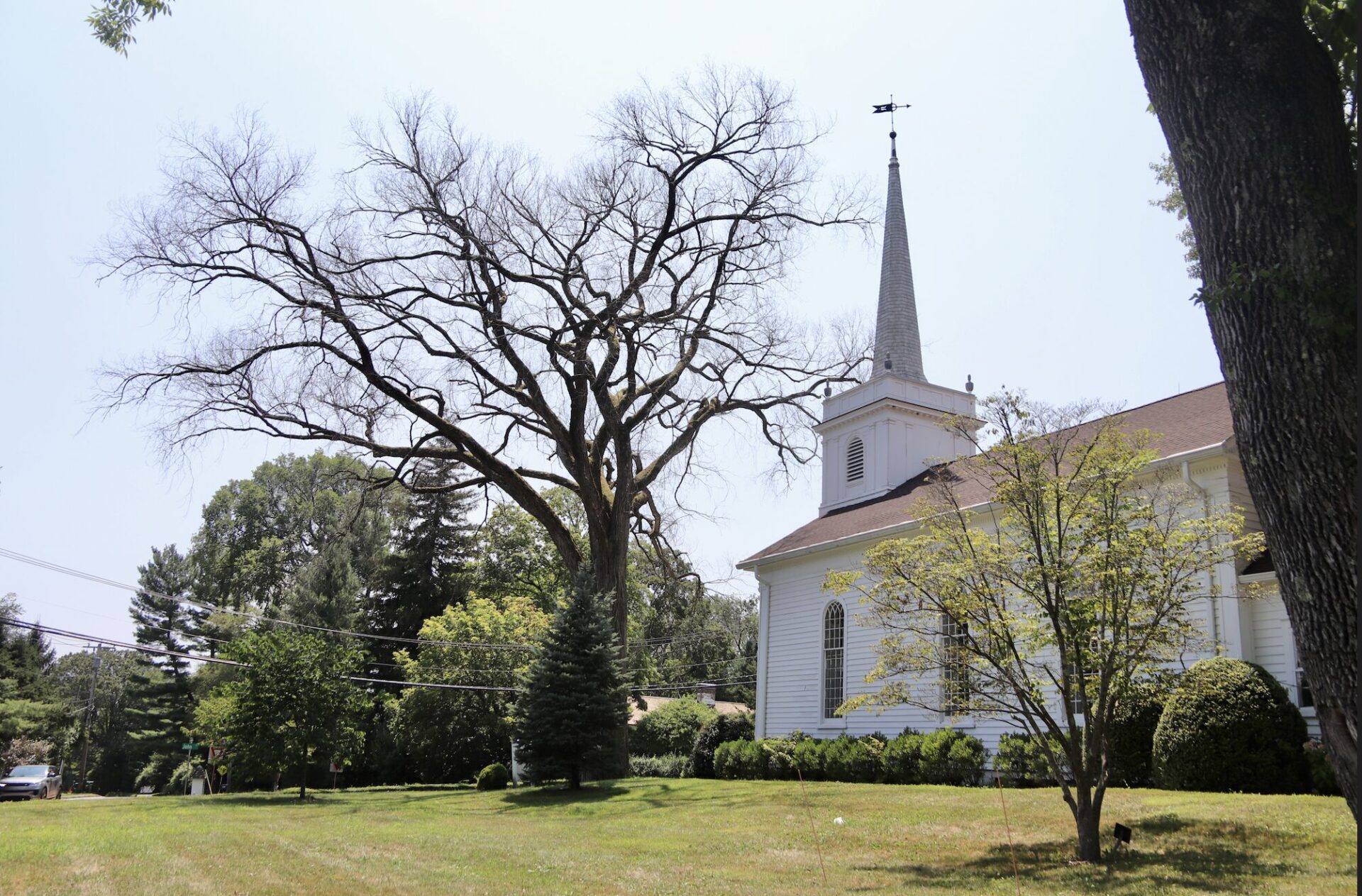
A majestic Elm Tree on the grounds of First Church of Round Hill Road in Greenwich has sadly died and must be removed. The tree, which stands prominently on the corner Round Hill Road and John Street, is a source of peace and tranquility in back country.
The tree, which poses a danger to the church and roadway, will be replaced with a disease resistant Valley Forge Elm Tree at the recommendation of the town tree warden, that will eventually have a similar shape and be climate resistant.
John Conte was president of Greenwich Tree Conservancy when he died unexpectedly on April 22.
Over the years he was involved with many organizations around town. In addition to his 40 years of experience in arboriculture, landscape architecture and construction, he served on the boards of the Greenwich Land Trust, Greenwich Audubon, and Family Centers. He also had extensive leadership experience at the Round Hill Association and Greenwich Green & Clean.
Leslie Lee, who is serving as interim president of the board of directors of the Greenwich Tree Conservancy until a new president is elected at the organization’s annual meeting in January, said there are plans to dedicate the new tree in memory of Mr. Conte, who married his wife Kim in First Church of Round Hill in 1983.
The church is responsible for the tree removal, but Ms Lee said the Greenwich Tree Conservancy had been receiving contributions in Mr. Conte’s memory that they plan to use toward the stump grinding to make it easier to plant a new tree nearby, and to pay for the new tree.
She said Mr. Conte always loved the Elm Tree on the church property and noted that in fact, even without leaves its branches are gracious and impressive.
There are plans in the works for a planting ceremony in the fall when the weather has cooled down and the tree will have a better chance to get established.
In the meantime, a variety of organizations that Mr. Conte was involved with will have a chance to participate in funding the new tree as a lasting tribute to him and his love of trees throughout town.
The First Church of Round Hill in Greenwich dates back to 1810. The original church building was dedicated in 1828, and moved across the street to its current location in 1871.
Read the article in the Greenwich Free Press
Church Leadership Transfers Dingletown Church to Greenwich Land Trust
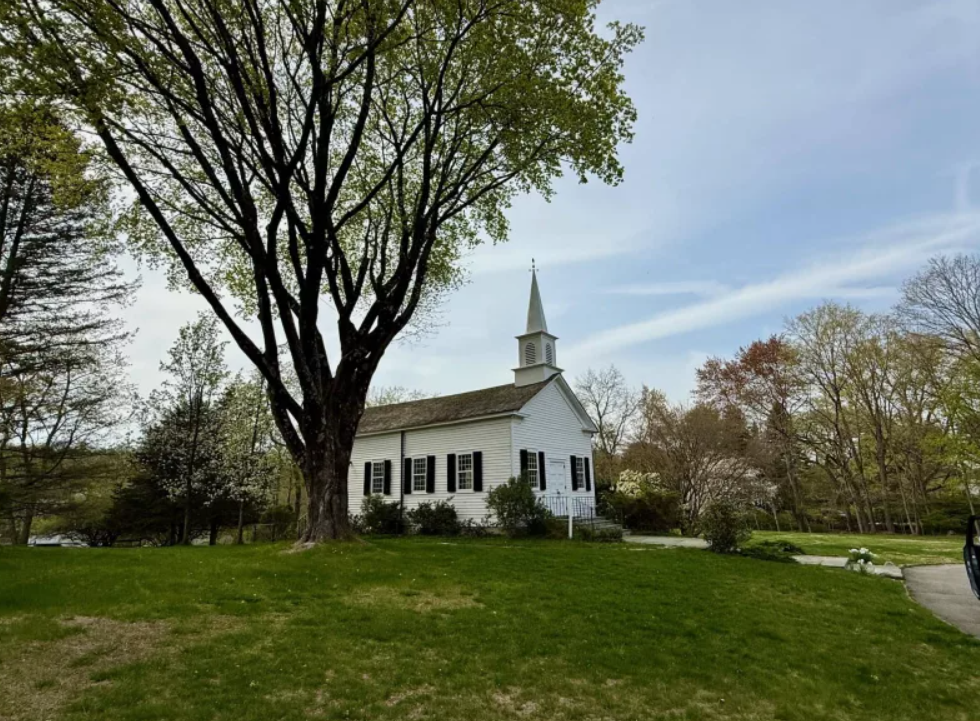
On Friday, April 25th, the historic Dingletown Church property, located at 376 Stanwich Road, was transferred to Greenwich Land Trust with the goal of protecting this special and historic place.
Greenwich Land Trust, in collaboration with the Dingletown Church leadership, crafted a robust set of preservation restrictions and a deeded conservation easement to protect the integrity of the site’s landscape, the historic character of the church building, and the pastoral beauty of the neighborhood.
The Dingletown Church’s leadership initiated this generous donation and was visionary in making this possible.
Greenwich Land Trust is currently discussing transferring the property to the Greenwich Tree Conservancy, a local environmental organization whose mission is to plant, preserve and protect the urban forests of Greenwich for the benefit of community health and quality of life.
The Greenwich Tree Conservancy would serve as the property’s long-term steward, ensuring the site is preserved in alignment with the preservation and conservation restrictions established by Greenwich Land Trust and Dingletown Community Church and made accessible to the Greenwich community in a thoughtful and meaningful way.
Read the article in the Greenwich Sentinel

By Kate Dzikiewicz
Whether large or small, property development projects in Greenwich often result in tree removal. Most of these projects now include robust planting plans to replace lost trees, and native species are chosen more often than they were in years past. It is wonderful to see urban planning and development including more environmental and ecological components, but the trend of removing mature trees and replanting young ones represents a significant blind spot. The beneficial local impact of a mature tree takes decades to achieve, and no number of saplings can replace that.
A mature tree has an extensive canopy and innumerable leaves. This makes them very effective at reducing airborne pollutants in an urban area, such as particulate matter, ozone, sulfur dioxide, carbon monoxide, and nitrogen monoxide. Some of these pollutants are absorbed by the tree and transformed into less harmful substances while others adhere to the leaves and bark of a tree and are washed away by rain. Research has shown that a tree with a 30-inch diameter trunk has around 100 times more leaf surface area than a 6-inch tree, allowing it to remove 10 times more air pollution. Most trees are planted in the 1.5 – 3-inch range, making them even less effective at cleaning the air.
Mature trees also help mitigate the urban heat island effect. Paved surfaces exposed to full sun can be 20-40 degrees hotter than shaded areas and have ambient air temperatures up to 9 degrees warmer. Large trees with wide canopies block sunlight and cool streets and buildings. The process of a tree drawing water from the soil and releasing it as vapor into the air provides even more evaporative cooling. Home and business owners experience much lower energy expenses in summer if they have large trees shading their property.
Shade cast by trees also preserves our local infrastructure. The sun’s ultraviolet rays degrade asphalt over time and makes roads brittle and prone to damage. Street trees prevent this damage and reduce road resurfacing costs by 15-60%, depending on the level of canopy coverage.
Another way that trees help our infrastructure is by diminishing stormwater runoff. Greenwich experienced a particularly rainy spring this year and we can expect increasing weather variability in the years to come. Trees help manage stormwater by improving soil permeability and absorbing water through their roots. Mature trees are about three times more effective than young trees at reducing water runoff thanks to their extensive root systems and broad canopies that slow rainfall before it reaches the ground.
Across nearly every environmental metric, mature trees deliver significantly more benefits than their younger counterparts, which take decades to reach the same size and impact. The removal of mature trees needs to be recognized as a generational loss to a community and avoided whenever possible for that reason. These trees represent the investment of many decades of patience and care which can only be replaced by an equal amount of time and attention. It may be easier to remove large trees during construction and plant new ones afterward, but with careful planning trees can often be preserved, even next to active building sites!
To protect the health of our community, reduce energy costs, and maintain a resilient environment, it is essential that we prioritize the preservation of mature trees in our urban landscapes.
Kate Dzikiewicz
Executive Director, Greenwich Tree Conservancy
Read the article in the Greenwich Sentinel
Greenwich Sentinel: The Woman’s Club of Greenwich Proudly Presented Our 2025 Philanthropic Awards

A big “Thank You!” to the Woman’s Club of Greenwich for your generous award in support of our mission.
Click here to read about it on page 6 of this week’s issue of the Greenwich Sentinel.
Greenwich Free Press: Greenwich Tree Conservancy New President, John Conte
The Greenwich Tree Conservancy Board of Directors is thrilled to announce the election of John R. Conte, RLA, ASLA, as the new president of the Board of Directors. With over 40 years of experience in arboriculture, landscape architecture and construction, Conte brings a wealth of expertise to the GTC and a deep commitment to preserving and enhancing Greenwich’s natural beauty.
 Beyond his professional accomplishments, Conte has been highly involved in the Greenwich community for many years. He has previously served on the boards of the Greenwich Land Trust, Greenwich Audubon, and Family Centers Inc, and has extensive leadership experience as president of the board of the Round Hill Association and Greenwich Green & Clean.
Beyond his professional accomplishments, Conte has been highly involved in the Greenwich community for many years. He has previously served on the boards of the Greenwich Land Trust, Greenwich Audubon, and Family Centers Inc, and has extensive leadership experience as president of the board of the Round Hill Association and Greenwich Green & Clean.
Click here to read the full press release on the Greenwich Free Press.
Greenwich Patch: Greenwich To Plant 100 Trees Along Post Road Corridor
From the Greenwich Patch, October 29th:
“GREENWICH, CT — At long last, Greenwich will plant 100 trees along the Post Road corridor from Port Chester, N.Y., to Stamford in an effort to create a tree-lined gateway into New England.
An inaugural planting event will take place at 11:30 a.m. at 600 East Putnam Ave. in Cos Cob on Nov. 1. Up to 90 of the approved trees will go in the ground, and the remaining trees will be planted in the spring.
“This effort was one of the things I pledged to work on back in 2019 and found very willing partners in Planning & Zoning, DPW, the Tree Conservancy and others who led the way,” First Selectman Fred Camilo told Patch. “Having a tree-lined boulevard running through the middle of our town will be the first thing that many visitors see when they pass through Greenwich and what a beautiful sight it will be. It is something that will live beyond our lives and enrich the lives of those who come after us.”
Read the full story at Greenwich To Plant 100 Trees Along Post Road Corridor | Greenwich, CT Patch
Over 90% of American households own at least one car, and in Connecticut 77% of residents drive to work. Parking lots are ubiquitous in Greenwich but they do not have to be eyesores.
Since 2018, the Greenwich Tree Conservancy has prioritized the greening of town parking lots. This summer they have planted 14 additional trees in the William Street and Henry Street parking lots in Byram as part of their “Parking Parks” initiative.

Unshaded pavement can be up to 45° F hotter than shaded areas, significantly contributing to the heat island effect seen in urban spaces. One of the simplest yet most effective methods to combat this problem is by planting trees. The shade provided by trees helps keep parking lots and cars cooler, but they also provide many other benefits to human health and the environment.
Click here to read the full press release on Greenwich Free Press.
Greenwich Sentinel – Notable Trees of Greenwich: A Greenwich Tree Conservancy Project
By Chery Dunson and Sue Baker, Advisory Board Chairs
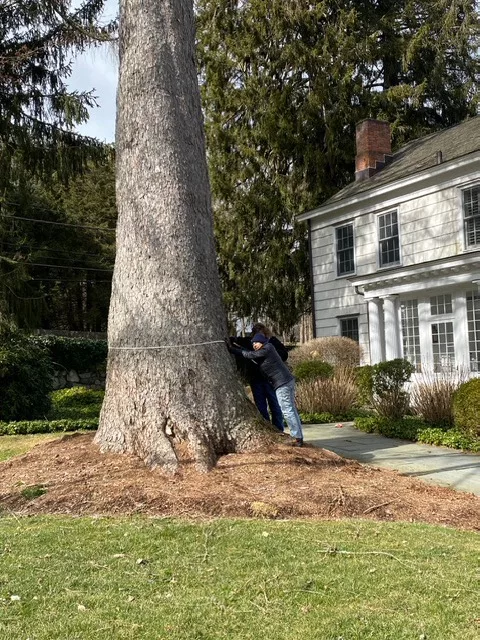
Greenwich is fortunate to have an extensive tree canopy providing a vivid and kaleidoscopic display of color and form throughout our spring, summer and fall seasons. Trees line our streets. They stand in our parks, on our school grounds, and make up our woodlands. They adorn the yards around our homes. Trees provide benefits to town residents by shielding us from heat and cold, purifying our air and water and significantly reducing stormwater flooding. They soften the noise from ever increasing traffic and the visual impact of our urban built environments. Along with all this they provide food and shelter essential to birds and other wildlife.
Among the many thousands, there are exceptional trees notable for their great size, unusual species or historic or social significance. In the 1980s, the Connecticut College Arboretum established the statewide Notable Tree program, surveying towns across Connecticut. The program identified over 100 notable trees on public and private lands in Greenwich. If you are interested in learning more about the Connecticut College Arboretum Notable Trees project you can visit – http://oak.conncoll.edu:8080/notabletrees/
Until recently, the status of many of the Greenwich listed trees was unknown. Throughout the past year, the Greenwich Tree Conservancy has located many of these trees providing an update of the town’s listing. We have determined if the trees are still alive and healthy, their current size and status, or if they had been removed.
The process is straightforward. We reach out to property owners requesting permission to access their property to verify the status of the tree. A team of three volunteers locates each tree and takes measurements to determine the diameter of its trunk, the spread of its crown, and its overall height. Each of these measurements contributes to an overall rating as established by American Forestry Association. This information is provided to the CT College Arboretum in order to update the Greenwich listing. Among our town’s Notable Trees are Oaks, Horse Chestnuts, American Sycamores, London Planetrees and Japanese Zelkovas.
To date, we have verified the status of all the notable trees on public lands. Additionally, half of the private property owners have granted us access. We would like to thank the numerous property owners who beyond granting us access have enabled these notable trees to survive and thrive over the decades!
Some verified notable trees you can look for on public lands include a Sweetgum (Liquidamber styraciflua), Swamp White Oak (Quercus bicolor) and Black Oak (Quercus velutina) in Bruce Park. A London Planetree (Platanus acerifolia) at the Board of Education building at 290 Greenwich Avenue. A Thread Leaf Japanese Maple (Acre palmatum‘Dissectum’ ), Monkey Puzzle Tree (Araucaria araucana), Thayer Yew (Taxus media ‘Thayerae’) and Sargent’s Weeping Hemlock (Tsuga canadensis ‘Sargentii’) in the Montgomery Pinetum in Cos Cob. An American Sycamore (Platanus occidentalis) at North Mianus School and a Horse Chestnut (Aesculus hippocastanum) on Sound Beach Avenue in Old Greenwich.
This is an ongoing project for the Tree Conservancy and we are now turning our attention to adding new trees to the CT College Notable Tree listing for Greenwich. If you have a tree on your property that you believe may be notable for its size, species or historic significance, or if you delayed responding to our letter, you may contact us at: arboretum@greenwichtreeconservancy.com.
To find out more about the Greenwich Tree Conservancy, visit us at: www.greenwichtreeconservancy.org.
We look forward to hearing from you!
This article originally appeared in the Greenwich Sentinel on Friday, August 16, 2024. Click here to view.
Last Thursday Greenwich’s superintendent of Parks & Trees/Tree Warden, Dr. Greg Kramer held a zoom public hearing about a mature Honey Locust tree at 125 Greenwich Ave requested by the owner of Shreve Crump & Low to be cut down because its roots were impacting the sidewalk.
The tree, “Gleditsia Triacanthos” has a DBH (diameter at breast height) of 26 inches.
The tree is in front of Shreve Crump & Low.
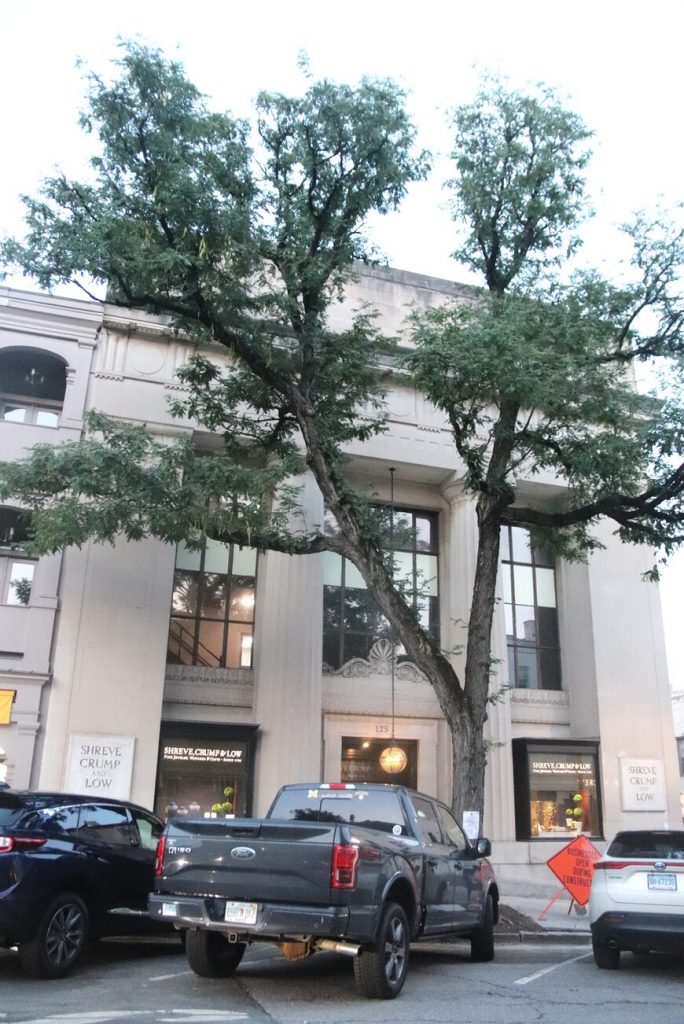
First Selectman Fred Camillo testified that the issue with the sidewalk was a trip hazard and urged the tree be replaced.
Kate Dzikiewicz, director of the Greenwich Tree Conservancy, and the former director JoAnn Messina, as well as board chair Peter Malkin all spoke in favor of sparing the tree and figuring out a workaround.
Ms Messina the new Belgian block lined tree wells in the sidewalks all along Greenwich Avenue were a trip hazard.
Ms Dzikiewicz said the Tree Conservancy could assist with expenses of analyzing the tree roots and possibly installing ramps.
Several town residents also urged the tree warden to spare the tree.
[Story continues – read the full article at https://greenwichfreepress.com/news/government/town-tree-warden-rules-sympathetically-to-decades-old-honey-locust-on-greenwich-ave-220399/ ]
Greenwich Sentinel: Cheers to Our Trees 5.10.2024

Read the article on page 3 of the digital newspaper at GreenwichSentinel-5-10-24.pdf
NY Times: Why Aren’t We Saving the Urban Forests?
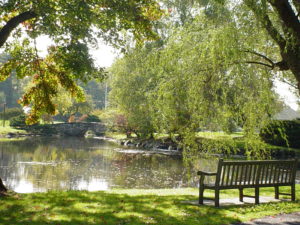
A great op ed written by Margaret Renkl titled “Why Aren’t We Saving the Urban Forests?” was featured in the NY Times on April 22nd.
By Anne W. Semmes
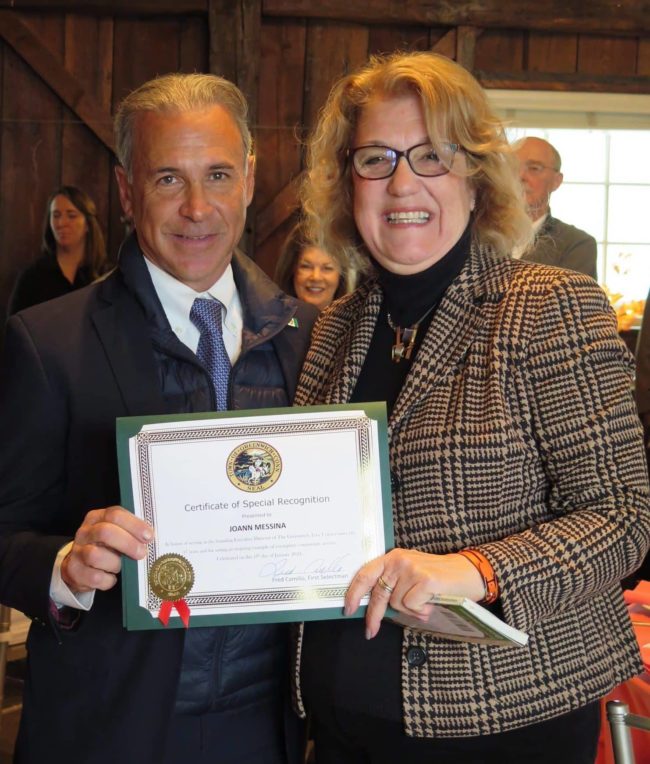
Just how a town can come together to green its public spaces with trees was plain to see last Friday at a gathering of some 55 Town Greenwich officials and nonprofit leaders in the Barn at the Greenwich Historical Society. The occasion was a “Goodbye” arranged by the Greenwich Tree Conservancy (GTC) for its long-serving executive director JoAnn Messina, retiring after 17 years from the inception of the GTC, during which 6,000 trees were added to the Town.
Read the full article at How the Greenwich Tree Conservancy builds a community of tree lovers and tree planters – Greenwich Sentinel
Greenwich Sentinel: Treasured Tree Tales Told by Winners
Click here to view the online article in the Greenwich Sentinel.

Greenwich Free Press: Greenwich Sustainability Committee Speaker Series – Save the Dates
Join the Sustainability Committee for informative and educational discussions on how the Greenwich Sustainability Sectors are responding to the challenges of the climate crisis.
The Speaker Series takes place at the Second Congregational Chapel from 1:00 – 2:30pm
Please visit our webpage: greenwichct.gov to sign up for our newsletter and follow us @greenwichsustainability to receive updates.
LAND AND WATER: September 28, 2023
Forests, Trees and Brain Health
Community Partner: Greenwich Tree Conservancy
WASTE REDUCTION: October 24, 2023
Waste Injustice: Impacts and Solutions
Community Partner: Waste Free Greenwich
COMMUNITY CULTURE: November 28, 2023
Building Ecological Climate Resilience Through Native Plant Landscaping
Community Partner: Greenwich Land Trust
FOOD SYSTEMS: January 30, 2024
Regionalizing the Food System in Response to Climate Change
Community Partners: Greenwich Community Gardens and The Foodshed Network
LEGISLATION AND ADVOCACY: February, 2024
BUSINESS: March 26, 2024
The Business Case for Sustainability: Why is it Important for Business to Adopt Sustainable Practices?
CLIMATE RESILIENCY: April, 2024
Climate Change Impacts in Greenwich: What Do We Need to Prepare For and How?
TRANSPORTATION AND AIR QUALITY: May 28, 2024
Spare the Air: Smog Season Starts with a Call to Drive Less and Landscape Responsibly
Contact Kim Gregory @ staglanefarm@yahoo.com with any questions.
Greenwich Sustainability Committee Speaker Series is in partnership with Coffee for Good and Second Congregational Church.
Original Source: Greenwich Sustainability Committee Speaker Series: Save the Dates | Greenwich Free Press
More info on this month’s event. To RSVP, email Kim Gregory at staglanefarm@yahoo.com.
